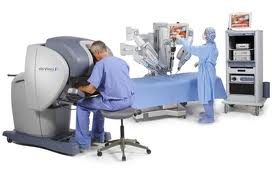|
| |
Benefits of Robotic surgery
Main
Article page |
Beauty articles
|
Health page |
Computers|
Diseases |
Education |
Entertainment |
Family
Business |Fitness|
Fruits and Vegetables
|
Jobs |
General |
Personality|
Technology
|
Tourism |
Useful Tips
General Knowledge |
Biography Page|
Heroes & Incredible peoples
|
Inventions
Health Page|
Diseases and Remedies |
Articles|
List of diseases

Robotic surgery is a type of minimally invasive surgery. “Minimally
invasive” means that instead of operating on patients through large
incisions, they use miniaturized surgical instruments that fit through a
series of quarter-inch incisions. When performing surgery with the da Vinci
Si—the world’s most advanced surgical robot—these miniaturized instruments
are mounted on three separate robotic arms, allowing the surgeon maximum
range of motion and precision. The da Vinci’s fourth arm contains a
magnified high-definition 3-D camera that guides the surgeon during the
procedure.
The surgeon controls these instruments and the camera from a console located in
the operating room. Placing his fingers into the master controls, he is able to
operate all four arms of the da Vinci simultaneously while looking through a
stereoscopic high-definition monitor that literally places him inside the
patient, giving him a better, more detailed 3-D view of the operating site than
the human eye can provide. Every movement he makes with the master controls is
replicated precisely by the robot. When necessary, the surgeon can even change
the scale of the robot’s movements: If he selects a three-to-one scale, the tip
of the robot’s arm will move just one inch for every three inches the surgeon’s
hand moves. And because of the console’s design, the surgeon’s eyes and hands
are always perfectly aligned with his view of the surgical site, minimizing
surgeon fatigue.
The ultimate effect is to give the surgeon unprecedented control in a minimally
invasive environment. As one of our surgeons notes, “It’s as if I’ve
miniaturized my body and gone inside the patient.” Utilizing this advanced
technology, our surgeons are able to perform a growing number of complex
urological, gynecological, cardiothoracic and general surgical procedures. Since
these procedures can now be performed through very small incisions, our patients
experience a number of benefits compared to open surgery, including:
-
Less trauma on the body
-
Minimal scarring, and
-
Faster recovery time
Q: Why is the Robotic Surgery System called
the da Vinci® S Surgical System?
The product is called "da Vinci" in part because Leonardo da Vinci invented
the first robot. He also used unparalleled anatomical accuracy and
three-dimensional details to bring his masterpieces to life. The da Vinci
Surgical System similarly provides physicians with such enhanced detail and
precision that the system can simulate an open surgical environment while
allowing operation through tiny incisions.
Q: Is a surgeon using the Robotic System operating in "virtual reality"?
Although seated at a console a few feet away from the patient, the surgeon
views an actual image of the surgical field while operating in real-time,
through tiny incisions, using electromechanically enhanced instruments. At no
time does the surgeon see a virtual image or program/ command the system to
perform any maneuver on its own/outside of the surgeon's direct, real-time
control.
Q: What is Minimally Invasive Surgery (MIS)?
MIS is surgery typically performed through small incisions, or operating
ports, rather than large incisions, resulting in shorter recovery times, fewer
complications, reduced hospitalization costs and reduced trauma to the patient.
MIS has become standard-of-care for particular surgical procedures; it has not
been widely adopted for more complex or delicate procedures - for example,
prostatectomy and mitral valve repair.
Intuitive Surgical believes that surgeons have been slow to adopt MIS for
complex procedures because they generally find that fine-tissue manipulation -
such as dissecting and suturing - is more difficult and less precise than in
open surgery. Intuitive Surgical's technology, however, enables the use of MIS
technique for complex procedures.
Q: Will the Robotic System make the surgeon unnecessary?
On the contrary, the da Vinci System enables surgeons to be more precise,
advancing their technique and enhancing their capability in performing complex
minimally invasive surgery. The system replicates the surgeon's movements in
real time. It cannot be programmed, nor can it make decisions on its own to move
in any way or perform any type of surgical maneuver without the surgeon's input.
Q: What are the benefits of using the Robotic System over more traditional
methods of surgery?
Some of the major benefits experienced by surgeons using the da Vinci S
Surgical System over traditional approaches have been greater surgical
precision, increased range of motion, improved dexterity, enhanced visualization
and improved access. Benefits experienced by patients may include a shorter
hospital stay, less pain, less risk of infection, less blood loss, fewer
transfusions, less scarring, faster recovery and a quicker return to normal
daily activities. Individual results may vary.
Q: While using the Robotic System, can the surgeon feel anything inside the
patient's chest or abdomen?
The system relays some force feedback sensations from the operative field
back to the surgeon throughout the procedure. This force feedback provides a
substitute for tactile sensation and is augmented by the enhanced vision
provided by the high-resolution 3D view.
Q: What type of surgical procedures are currently available using the Robotic
System?
Specially trained surgeons, including gynecologic oncologists, pediatric
urologists, a pediatric surgeon, reproductive endocrinologist, a bariatric
surgeon, a cardiac surgeon and urologists are performing the following;
prostatectomies; hysterectomies; tubal ligation reversals; removal of ovaries;
fallopian tubes and fibroid tumors; kidney reconstructive surgery; surgical
weight loss; cardiac surgery; and other delicate procedures using robotic
surgery.
( Reference
http://robotic-surgery.med.nyu.edu
, Abington Memorial Hospital http://www.amh.org/
)
Read more about
Robotic surgery...................
Related Articles:
| |
|



